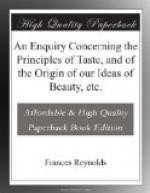In brief, the Enquiry is what one might expect from an intelligent amateur, from one not a professional writer, yet one who has given much thought to the problems of aesthetics. Of course, many of the ideas are derivative, with echoes of the “moral sense” of Hutcheson, the “line of grace” of Hogarth, and the terrible sublime of Burke. The three divisions of the essay—the development of a mental system, the origin of our ideas of Beauty, and the analysis of taste—follow the customary pattern of eighteenth-century discussions. Yet the piece is no slavish refurbishing of old phrases. It is packed with fresh arguments and novel suggestions. If these are not always completely coherent or logical, they do represent original thinking.
Twentieth-century readers may be astonished by some of the ideas: witness the claim that Negroes could never arrive at true taste, because their eyes were so accustomed to objects diametrically opposite to taste. As a further example of Miss Reynolds’ occasionally muddled thinking there is the development of her initial assumption. While the groundwork of man is perfection, this perfection has been blemished and man is impelled to recapture it in the sublime. Yet instead of analyzing this impulse, Miss Reynolds appears to take it for granted. Nor does she consider how perfection is to be achieved in taste, preferring to conclude with a diatribe in the manner of Rousseau on the depravity of the times and the corrupting effect of the arts. (For this and many of the following comments I am indebted to Mr. Ralph Cohen of the College of the City of New York.)
The cause of some of the ambiguities in her discussion may perhaps be traced to a rather careless use of terms. At one time “instinct” or “impulsion,” the moral force driving man toward perfection, is a potentiality developed by cultivation, and at another a force that is created by cultivation. Although the sublime is the apex of her mathematically-definite program and is a moral quality attained by the few, every human being has his point of sublimity in the idea of a Supreme Being. On the one hand, beauty is a preconceived idea in the human species; on the other it is not preconceived, but developed. Finally, the rules of art are perceptions of moral virtue, yet art which exhibits these rules can corrupt.
It is easy to pick flaws in Miss Reynolds’ thinking, for the lack of sustained logic which Johnson early recognized is apparent at every turn. Yet for students of the history of ideas the Enquiry contains much of interest. As a painter, Miss Reynolds throughout stresses the visual, a concentration which leads her to several valuable insights. She divides form into two categories, masculine and feminine, but makes a novel use of these Ciceronian divisions. All non-human objects—flowers, animals, etc.—are seen as exhibiting male or female attributes. It might almost be said that with this anthropomorphic approach she is attempting to develop a “philosophical” basis for the pathetic fallacy. Furthermore, if the human is used to measure beauty in the non-human, the implication is that man, not God, is the measure of beauty. By setting up man as the mediator between the material and the divine, she points to the concentration in the next century on human values.




